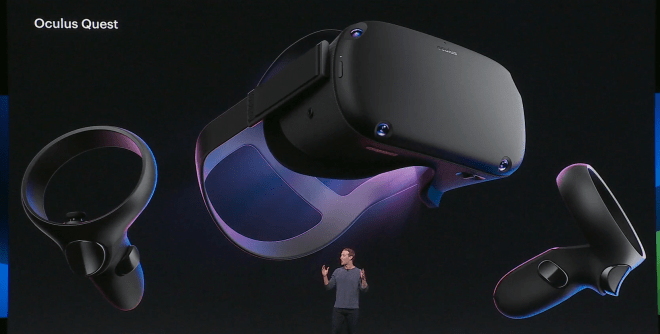
The Oculus Quest has now been shipping units since May 21st, 2019, for exactly one week, and I have been closely monitoring the Oculus Quest subReddit channel and other news sources to find out how things have been going.
And so far, things have been going like gangbusters! Many stores such as Amazon, Walmart, and Best Buy report being completely sold out of the Quest, and some people are posting messages on the Oculus Quest subReddit, desperately searching for a location that can ship the product (or that they can drive to and pick one up) without having to wait weeks. People report making road trips of several hours to find the last store in their area that has a Quest in stock! Right now, Amazon Canada estimates delivery sometime between June 18th and July 11th if you order the model with 64GB memory today. Your best bet might be the Oculus website, which says they will ship by June 7th if you order today. So yes, you can call the launch a resounding success.
Furthermore, many of those early adopters are giving demonstrations of VR to their family, friends, and colleagues, and many of those people are instantly sold on the Oculus Quest, and go out and buy their own device. Virtual reality is one of those things that is best experienced live, and the Oculus Quest is tailor-made to give demos, since it is standalone headset, easy to transport and easy to set up. It’s also a sizable step up from the rather disappointing cellphone-based VR that is all that some people have experienced so far. The Quest is a game-changer.
In my first week, not only have I spent CDN$699 on the Oculus Quest headset with 128GB of memory, I have also spent almost CDN$100 on games and apps for the device:

I understand that Facebook is taking a 30% cut of the sales on the Oculus Store. Some people speculate that Facebook is actually selling the Quest hardware at a loss, just so they can make money on selling games and apps. The astonishing consumer uptake of the Oculus Quest will certainly attract software developers, once they realize that they have a potentially large audience to sell to. Expect a huge increase in the number of apps on the Oculus Store as the year goes on. There’s probably going to be some fantastic Black Friday sales, too! In fact, somebody has already created a website to help you pick out new apps as they are released.
So, what do I think of the Oculus Quest so far? I am absolutely enchanted. The first apps on the Oculus Store appear to be solid. Beat Saber and Dance Central promise to give me a calorie-burning workout at a time when I am already trying to lose weight via Weight Watchers. Wander uses Google Earth 360-degree photography to allow me to wander the world. (I spent some time visiting the pre-fire Notre Dame Cathedral in Paris, and admiring the view from the Eiffel Tower observation deck yesterday evening.) Nature Treks VR allows me to meditate in beautiful scenery. Tilt Brush (which was free for me, as I already had purchased it for the Oculus Rift) allows me to express my creative side. There’s really no downside to this. This gadget is the new iPhone, the new iPad, the new PlayStation. I’m sold.
The only real problem that I have experienced is that I simply do not have enough big, empty space in my rather small apartment to really experience the boundless freedom of the wireless Oculus Quest. Often, especially when I play Beat Saber or Dance Central, I brush my hand up against the Guardian boundary system that lights up and warns me when I get too close to walls or other physical obstacles. It’s annoying, and I want more space! I’m seriously considering completely redecorating my living room, throwing out my coffee table and some other furniture so I can create a bigger open space in which to play.
Now, I do have an obliging empty patch of grass located just outside my apartment that would do the trick for true “room-scale” VR. While Oculus does not recommend using the device outside (because you can easily damage the lenses in the Quest by direct exposure to bright sunlight), many people have reported being able to use the device around sunset outdoors without problem. (Of course, having my apartment neighbours wonder what the hell the fat man is doing as he flails around outdoors in a wireless headset and hand controllers is another problem entirely.)
So, as I predicted, the Oculus Quest is a hit, and it promises to bring many more consumers into virtual reality. And, if you’re sitting on the fence, I encourage you to demo a friend’s unit for yourself, and see what all the fuss is about.


